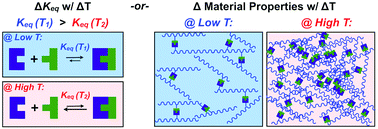Temperature-responsive supramolecular hydrogels
Abstract
Hydrogels comprise a class of soft materials which are extremely useful in a number of contexts, for example as matrix-mimetic biomaterials for applications in regenerative medicine and drug delivery. One particular subclass of hydrogels consists of materials prepared through non-covalent physical crosslinking afforded by supramolecular recognition motifs. The dynamic, reversible, and equilibrium-governed features of these molecular-scale motifs often transcend length-scales to endow the resulting hydrogels with these same properties on the bulk scale. In efforts to engineer hydrogels of all types with more precise or application-specific uses, inclusion of stimuli-responsive sol–gel transformations has been broadly explored. In the context of biomedical uses, temperature is an interesting stimulus which has been the focus of numerous hydrogel designs, supramolecular or otherwise. Most supramolecular motifs are inherently temperature-sensitive, with elevated temperatures commonly disfavoring motif formation and/or accelerating its dissociation. In addition, supramolecular motifs have also been incorporated for physical crosslinking in conjunction with polymeric or macromeric building blocks which themselves exhibit temperature-responsive changes to their properties. Through molecular-scale engineering of supramolecular recognition, and selection of a particular motif or polymeric/macromeric backbone, it is thus possible to devise a number of supramolecular hydrogel materials to empower a variety of future biomedical applications.

- This article is part of the themed collection: Journal of Materials Chemistry B Recent Review Articles


 Please wait while we load your content...
Please wait while we load your content...
